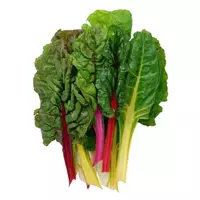Mangold

Mangold, which also bears the names leaf or beetroot beetroot, is a two-year-old herbaceous plant in the "amaranth" family. Being a subspecies of our usual beetroot, in its appearance it resembles spinach more, thanks to its long stems and leaves. Depending on the shape of the leaves and the color of the stem, this plant is divided into many varieties. Chard is a very beautiful plant: with its help, gardeners often decorate their personal plot and even a flower garden.
For culinary purposes, this green is widely used in the preparation of various dietary dishes, since with a low calorie content of chard (19 kcal per 100 grams), it includes a whole complex of natural vitamins and minerals. However, freshly cut foliage is advised to immediately eat, since this delicate plant cannot be stored for long periods even in the refrigerator. Most often, young petioles and leaves are used until they have chopped up and lost their juiciness.
Mangold is used in kitchens around the world to prepare a wide variety of dishes. For example, one of the traditional dishes on the table of Italians is the fleshy-juicy petioles and leaves of this plant, prepared in a variety of ways. There he is called "batter, " which in translation from the Celtic language means "red. " This is due to the color of the leaf beet, in which the lower part of the petioles and the roots are really of this color.
The beneficial properties of chard are fully revealed in the early spring period, when there are still very few green products rich in vitamins. Beetroot is used to prepare vinaigrettes, salads, soups, cold snacks and hot dishes, where it is stewed in lard or oil, like spinach. Try boiling chard petioles in salted water and then roasting - lick your fingers! The leaves can be sautéed with cabbage or separately. Along with the cucumbers, the hostess pickles the chard petioles, cutting and placing them in a jar vertically.
The benefits of chard
The benefits of chard are indicated by the content of a huge amount of vitamin K in its composition, as well as other useful substances such as sodium, magnesium and potassium. This tasty and at the same time healing plant is useful to eat for diabetes, obesity, anemia and kidney stone disease. By the way, chard juice, which is mixed with honey in equal proportions, is an excellent strengthening agent for colds.
The benefits of chard are beyond doubt, since with its regular use insoluble salts are excreted from the body, liver function improves and immunity increases.
The harms of chard
In addition to individual intolerance, speaking of the dangers of chard, it should be remembered that the freshly squeezed juice of this plant can cause drowsiness, nausea, vomiting, lower heart rate and blood pressure. This is due to the presence of a large amount of volatile substances, so drinking it is recommended only a couple of hours after squeezing.
19 kKal chard
Energy value of chard (Ratio of proteins, fats, carbohydrates - ju):
Proteins: 1.8 g (~ 7 kCal)
Fats: 0.2 g (~ 2 kCal)
Carbohydrates: 2.14g (~ 9kCal)
Energy ratio (bj | y): 38% | 9% | 45%
 Español
Español Français
Français Português
Português Русский
Русский 简体中文
简体中文 繁體中文
繁體中文 日本語
日本語 한국어
한국어 العربية
العربية Türkçe
Türkçe Қазақ
Қазақ Deutsch
Deutsch Italiano
Italiano Українська
Українська
